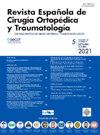Tratamiento de la fractura luxación radiocarpiana dorsal: resultados clínicos y radiológicos a largo plazo
Q3 Medicine
Revista Espanola de Cirugia Ortopedica y Traumatologia
Pub Date : 2025-03-18
DOI:10.1016/j.recot.2025.03.003
引用次数: 0
Abstract
Main
To describe our experience treating dorsal radiocarpal fracture-dislocations, regarding longterm clinical and radiological outcomes.
Material and method
Retrospective chart review of 15 patients treated in our institution from 2007 to 2021. Inclusion criteria were patients over 16 years, treated at a third level hospital of Madrid and an average follow up of 56 months. Epidemiological data were collected from digital records. VAS, QuickDASH and Patient Rated Wrist Evaluation (PRWE) scales were employed for clinical results assessment. All radiological studies were reviewed for radiological results assessment. A descriptive statistical analysis of all variables was developed.
Results
Among 15 patients with a mean follow-up of 56 months: 12 males (80%) and 3 females (20%) with a mean age of 39.5 years. The left wrist was injured in most cases (66.7%). All patients were treated surgically; 4 of them (27%) were assisted by wrist arthroscopy. Mean VAS at final follow up was 2.6 with activity. Mean PRWE was 32 and mean QuickDASH was 28, which means satisfactory results. 80% patients developed wrist stiffness with most affected flexo-extension followed by prono-supination. 67% patients developed radiological signs of wrist osteoarthritis at the end of follow-up.
Conclusions
In spite of a large number of clinical and radiological complications during follow-up, longterm functional results are good in this kind of wrist injuries.
治疗背侧放射性指骨骨折脱位:临床和放射学长期疗效。
主要:描述我们治疗桡腕背骨折脱位的经验,包括长期临床和影像学结果。材料和方法:回顾性分析我院2007 - 2021年收治的15例患者。纳入标准为16岁以上、在马德里三级医院接受治疗、平均随访56个月的患者。流行病学数据从数字记录中收集。采用VAS、QuickDASH和患者腕部评分量表进行临床结果评估。对所有放射学研究进行回顾,以评估放射学结果。对所有变量进行了描述性统计分析。结果:15例患者平均随访56个月;男性12例(80%),女性3例(20%),平均年龄39.5岁。左腕损伤最多(66.7%)。所有患者均行手术治疗;其中4例(27%)采用关节镜辅助。最终随访时平均VAS为2.6,伴有活动。平均PRWE为32,平均QuickDASH为28,结果满意。80%的患者出现手腕僵硬,受影响最大的是屈伸,其次是前旋。67%的患者在随访结束时出现腕骨关节炎的影像学征象。结论:尽管随访期间存在大量的临床和影像学并发症,但该类腕部损伤的远期功能效果良好。
本文章由计算机程序翻译,如有差异,请以英文原文为准。
求助全文
约1分钟内获得全文
求助全文
来源期刊

Revista Espanola de Cirugia Ortopedica y Traumatologia
Medicine-Surgery
CiteScore
1.10
自引率
0.00%
发文量
156
审稿时长
51 weeks
期刊介绍:
Es una magnífica revista para acceder a los mejores artículos de investigación en la especialidad y los casos clínicos de mayor interés. Además, es la Publicación Oficial de la Sociedad, y está incluida en prestigiosos índices de referencia en medicina.
 求助内容:
求助内容: 应助结果提醒方式:
应助结果提醒方式:


